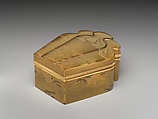Incense Box (Kōbako) in the Shape of Three Overlapping Jars
Barthélémy Paviet French
Not on view
This exquisite box was originally made in Japan in the mid-eighteenth century as an incense container. The lacquer surface is embellished with refined maki-e details, including young pine trees on the exterior of the lid and a continuous seashore on the sides with auspicious motifs. The incense box was exported to Europe either by the Dutch or through the China trade, a route similar to that taken by the Japanese lacquer boxes owned by Queen Marie Antoinette (1755–1793). In Paris, the small box was turned into a jewel-like object by Barthélémy Paviet, who applied gilded mounts over the rims and lined the inside with a gold-like metal sheet.
This image cannot be enlarged, viewed at full screen, or downloaded.
This artwork is meant to be viewed from right to left. Scroll left to view more.



